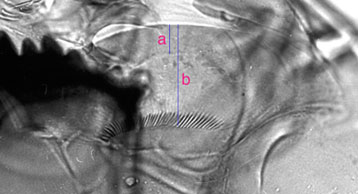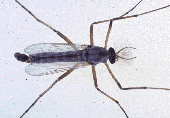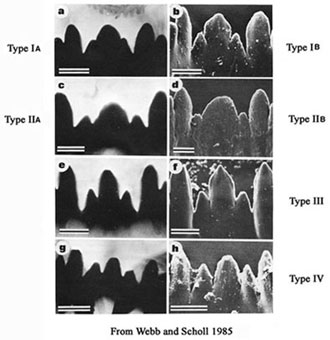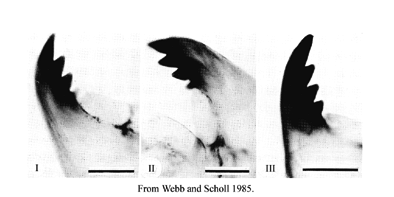Genetics Department, The University of Melbourne, Victoria, 3010, Australia
In general, the morphological terminology used in this document follows Sæther (1980), Webb & Scholl (1985) and Vallenduuk & Moller Pillot (1997). Species with an Australia-wide distribution
In the adult descriptions reference is made to the types of superior volsella shape as recognized by Strenzke (1959). This is a helpful initial classification, but experience has shown that the types are not discrete, but are part of a continuum. The three categories as described by Strenzke are:  1. Wing with dark spot over cross vein and with fuscous clouds, particularly in cell R5. . . . . . . . . . . . . . . . . . . . . C. pallidinubeculosus Wing with at most some darkening of cross vein . . . . . . . . . . . . . . . . . . . . . . . . . . . . . . . . . . . . . . . . . . . . . . . . . . . . . . . . . . . . 2. 2. Legs shorter than usual, posterior LR about 0.5; male hypopygium enlarged, anal point deep and laterally flanged . . . 3. Posterior LR about 0.7 or higher; male hypopygium of normal type . . . . . . . . . . . . . . . . . . . . . . . . . . . . . . . . . . . . . . . . . . . . 4. 3. Thorax dull grey, pits of dorsocentral setae very distinct; inferior volsella of male very swollen . . . . . . . . . . . . . . C. tepperi Thorax greenish with brown stripes, pits normal; inferior volsella of male not swollen . . . . . . . . . . . . . . . . . . C. magnivalva 4. Wing length greater than 5 mm; anterior tarsi of males bearded . . . . . . . . . . . . . . . . . . . . . . . . . . . . . . . . . . . . . . . . . . . . . . 5. Wing length less than 5 mm; anterior tarsi of males bearded or unbearded . . . . . . . . . . . . . . . . . . . . . . . . . . . . . . . . . . . . . 7. 5. Distributed on east of the continent, including Tasmania . . . . . . . . . . . . . . . . . . . . . . . . . . . . . . . . . . . . . . . . . . . . . . . . . . . . . 6. Distributed on the west of the continent, including Northern Territory . . . . . . . . . . . . . . . . . . . . . . . . . . . . . . . . C. occidentalis 6. Mid femur more than 1.12 times the anterior femur (likely to be) . . . . . . . . . . . . . . . . . . . . . . . . . . . . . . . . . . . . . . . C. duplex Mid femur shorter than the anterior femur (likely to be) . . . . . . . . . . . . . . . . . . . . . . . . . . . . . . . . . . . . . . . . . . . . . C. australis 7. Blackish species. Male with bearded anterior tarsi and spatulate superior volsella . . . . . . . . . . . . . . . . . . . . . . . C. 'timmsi' Paler species, at most brown. Male tarsi not bearded . . . . . . . . . . . . . . . . . . . . . . . . . . . . . . . . . . . . . . . . . . . . . . . . . . . . . . . . 8. 8. Thorax pale, anterior femur and tibia pale, tarsi with dark pattern, anal point long and tubular . . . . . . . . . . . . . . . . . . . . 9. Thorax partly pale but with lateral vittae darker, legs pale . . . . . . . . . . . . . . . . . . . . . . . . . . . . . . . . . . . . . . C. 'queenslandicus' 9. Tarsi darkened at both apex and base, anal point tubular. . . . . . . . . . . . . . . . . . . . . . . . . . . . . . . . . . . . . . . . . . . . . . C. javanus [Tarsi darkened only at distal ends, anal point larger and narrowed at base, . . . . . . . . . . . . . . . . . . . . . . . . . . . . . C. nr. samoensis [superior volsella boot shaped or beaked Chironomus cloacalis (Abdominal tergites generally dark with pale posterior band, but may have saddle spots; AR 3.34 - 4.24; LR 1.44 - 1.78), Chironomus 'februarius' (Abdominal tergites may be as C. cloacalis, or may have dark band across the centre of the segment; AR 2.9 - 3.4; LR 1.56 - 1.65.), Chironomus 'pseudoppositus' (Abdominal tergites as in C. cloacalis AR 2.5 - 3.1; LR 1.5 - 1.8; superior volsella less curved than in other members of the oppositus-group) Abdomenal tergites with saddle spots: Chironomus oppositus (LR 1.5 - 1.8; wing length 2.8 - 3.6, Chironomus maddeni (AR 2.55 - 2.86; LR 1.6 - 1.8; wing length 2.4 - 3.36 mm), Chironomus 'jacksoni' (AR 2.4 - 3; LR ); Chironomus 'tyleri' (AR 2.9 - 3.2; LR 1.53 - 1.66; wing length 4.3 - 4.5 mm). - need to be inserted at 8. Norfolk Island species: Species 1 may be near C. samoensis, superior volsella closest to Strenzke's type D(d), LR about 1.54 (i.e. lower than C. nr. samoensis, but in range of C. samoensis itself). Species 2 has an superior volsella that is closest to Strenke's type D(f), but appears to have a flattened end. LR about 1.27. In the following descriptions, reference is made to the mentum and mandible types originally devised by Webb & Scholl (1985), Vallenduuk & Moller Pillot (1997), and Proulx et al. (2013). These classifications were made for relatively small numbers of species, but with the much larger number of species, such as in the North American fauna, they do not cover all the variability seen in these characters and so further modification has been necessary. The MENTUM TYPE is defined only by the degree of development of the 4th lateral teeth: The mentum may be further classified by the characters of the CENTRAL TRIFID TOOTH: The MANDIBLE TYPE is defined by the degree of darkening and separation of the 3rd inner tooth: Separation: Type I - tooth fused Type II - tooth partially free Type III - tooth completely separated Color: Type A - tooth pale Type B - some degree of pigmentation Type C - as dark as other inner teeth VENTROMENTAL PLATE RATIO - ratio of the width of the marginal region of ventromentum (usually seen as a granular band under light microscopy) (a in figure below) to the distance from the anterior margin to the base of the striae (b in figure below).  VMR = a/b Larval types referred to in Key and in descriptions are defined here. 1. Larger larvae, length up to about 23 mm. (Either thick bathophilus-type larvae with large very darkly pigmented heads, or a slim plumosus-type larva with a small pale head capsule) . . . . . . . . . . . . . . . . . . . . . . . . . . . . . . 2 Medium sized larvae, length up to about 19 mm, ventral head length less than 400 µm. (bathophilus- or plumosus-type larvae with pale to moderately darkened gular or frontoclypeal regions) . . . . . . . . . . . . . . . . . . . . . . . . . . . . . . . . . . . . . . . . . . . . . . . . . . . . . . . . . . . . . 5 2. Head capsule heavily darkened, bathophilus. . . . . . . . . . . . . . . . . . . . . . . . . . . . . . . . . . . . . . . . . . . 3 3. Distributed on east side of the continent only (NSW, VIC, SA, Tas) . . . . . . . . . . . . . . . . . . . . . . 4 4. Teeth of mentum rounded (when not worn), side teeth of centre trifid tooth 5. Larvae with lateral tubules (NB. often polymorphic) . . . . . . . . . . . . . . . . . . . . . . . . . . . . . . . . . . . . . 6 6. Larvae of the true plumosus type (posterior VT coiled) . . . . . . . . . . . . . . . . . . . . . . . . . . . . . . . . . . . . 7 7. Head capsule generally darkened on both the gula and frontoclypeus . . . . . . . . . . . . . . . . . . . . . . . . 8 8. Both gula and frontoclypeus quite heavily darkened . . . . . . . . . . . . . . . . . . . . . C. cloacalis (majority) 9. c2 teeth of mentum sharp and well separated (type II) . . . . . . . . . . . . . . . . . . . . . . . . . C. nr. samoensis 10. Lateral tubules tending to be more ventrally placed, premandible with 7 teeth . . . . . . . . C. javanus 11. Head capsule often completely pale, but sometimes slightly darkened at posterior Basal segment of antenna more than 4 times as long as wide: 12. Larvae of the halophilus-type (i.e. ventral tubules reduced, often only 13. Head capsule pale . . . . . . . . . . . . . . . . . . . . . . . . . . . . . . . . . . . . . . . . . . . . . . . . . . . . . . . . . . . . . . . 14 14. Basal segment of antenna 3 to 3.5 times as long as wide; four polytene chromosomes . . . C. 'timmsi' 15. Antennal ratio A2/A1 more than 0.3 . . . . . . . . . . . . . . . . . . . . . . . . . . . . . . C. sp. (bathophilus-type) 16 Lateral tubule over 200 micron; antennal ratio A2/A1 more than 0.3; inner margins of |
Modified: 10 October 2015
Access: Unrestricted
Copyright © 2005-2015, Jon Martin.
Maintainer: Jon Martin j.martin@unimelb.edu.au
 AUSTRALIAN CHIRONOMUS
SPECIES
AUSTRALIAN CHIRONOMUS
SPECIES

